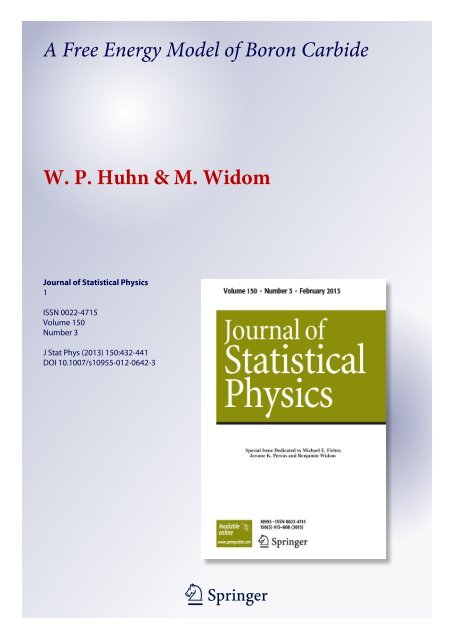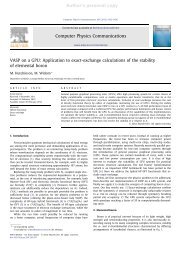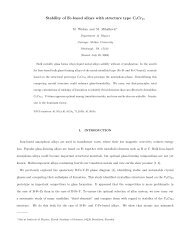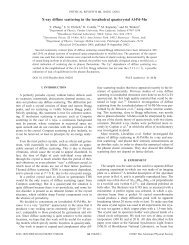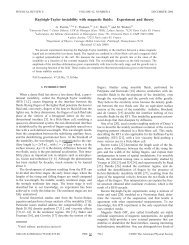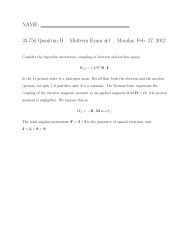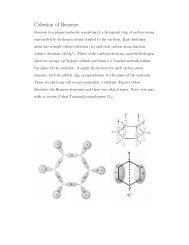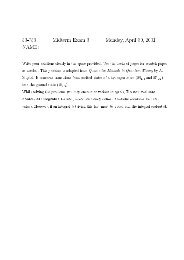A Free Energy Model of Boron Carbide W. P. Huhn & M ... - It works!
A Free Energy Model of Boron Carbide W. P. Huhn & M ... - It works!
A Free Energy Model of Boron Carbide W. P. Huhn & M ... - It works!
You also want an ePaper? Increase the reach of your titles
YUMPU automatically turns print PDFs into web optimized ePapers that Google loves.
A <strong>Free</strong> <strong>Energy</strong> <strong>Model</strong> <strong>of</strong> <strong>Boron</strong> <strong>Carbide</strong>W. P. <strong>Huhn</strong> & M. WidomJournal <strong>of</strong> Statistical Physics1ISSN 0022-4715Volume 150Number 3J Stat Phys (2013) 150:432-441DOI 10.1007/s10955-012-0642-31 23
2. then a penalty shoot-out will be held.Penalty DecidersYellow & Red CardsRefereesDecisionsEach team will nominate Three players to take their three penaltyshots. If scores are still level after three shots, substitutes must benominated, from the remaining members <strong>of</strong> the team, to continue theshoot-out on a sudden death basis. If scores are still level then teamsstart over.Any player receiving a red card may not be substituted in that game.The player will not be allowed to take any further part in theTournament. Two yellow cards in any one game equals a red.A player that accumulates three yellow-cards over the course <strong>of</strong> thetournament will not be allowed to take part in subsequent games.The referee shall not be approached or questioned about anydecision by any player or team <strong>of</strong>ficial other than the Team Captain.The captain may seek clarification about a decision in a propermanner but only when the ball is next out <strong>of</strong> play.The decisions <strong>of</strong> the Tournament Director will be final and no appealwill be allowed.
Author's personal copy434 W.P. <strong>Huhn</strong>, M. Widomto the α-boron structure, and a linear chain <strong>of</strong> 3 atoms lying along the 3-fold axis <strong>of</strong> the unitcell. The atomic positions <strong>of</strong> the icosahedra belong to two site classes: polar sites linkingthe icosahedra to each other, and equatorial sites linking the icosahedron to the chains.The distribution <strong>of</strong> carbon and boron atoms on these structural elements is uncertain.An idealized B 13 C 2 structure with rhombohedral symmetry occupies the twelve icosahedralsites with boron, while the three-atom chain takes the pattern C-B-C (i.e. the chain centeratom is boron and the terminal sites are carbon). However, first principles calculations [7,14] find that the most stable, enthalpy minimizing, structure is B 12 C 3 , with one carbon atomreplacing boron on a polar site <strong>of</strong> the icosahedron, breaking the rhombohedral symmetry.Experimentally [15], the phase appears to contain a mixture <strong>of</strong> characteristic motifs: B 12and B 11 C icosahedra; C-B-C, B-B-C, B-V-B and C-V-C chains (V = vacancy).The enthalpy minimizing B 12 C 3 structure has monoclinic symmetry, in disagreementwith the B 4 C phase’s observed rhombohedral symmetry. We propose that the phase knownas “B 4 C” should be renamed “B 13 C 2 ”, or simply “rhombohedral”, as we shall do for theremainder <strong>of</strong> this paper. We also claim that there exists a second phase, which is the trueB 4 C phase, that we term “monoclinic”. In the monoclinic phase, all <strong>of</strong> the carbons lie onequivalent polar sites <strong>of</strong> the icosahedra, making a well-ordered structure. Although there isan entropic term corresponding to the choice <strong>of</strong> this site, it is non-extensive and thus vanishesin the thermodynamic limit. In the absence <strong>of</strong> substitutional disorder the monoclinic phaseis a stoichiometric line compound (i.e., a compound with negligible solubility range at theexpected stoichiometry throughout the temperature range <strong>of</strong> interest, hereafter shortened to“line compound”).In previous work [10], we proposed a phase transition in which the monoclinic phasetransitions into the rhombohedral phase through the unlocking <strong>of</strong> degrees <strong>of</strong> freedom in theplacement <strong>of</strong> the polar carbons. Because the polar selection breaks the rotational symmetry<strong>of</strong> the B 12 icosahedron, we consider this as an orientational degree <strong>of</strong> freedom. Swapping Catoms among polar sites changes the orientations <strong>of</strong> the B 11 C icosahedra. The monoclinincphase aligns all icosahedra identically, while a phase transition to orientational disorder restoresrhombohedral symmetry. Landau theory [16] predicts no such transition occurs in therhombohedral phase, as the symmetry already matches the high T limit. Here, we constructan analytic model to interpret our previous computational results, from which we can derivean actual phase diagram.2 <strong>Free</strong> <strong>Energy</strong> <strong>Model</strong>Four solid phases compete for stability: elemental boron (β-rhombohedral), elemental carbon(graphite), and monoclinic and rhombohedral boron carbide. The first three phasesare modeled as line compounds throughout the entire temperature range, but rhombohedralboron carbide will be allowed a carbon composition ranging from B 14 C 1 (x = 1/15 = 0.067)to B 12 C 3 (x = 3/15 = 0.200). The stable T = 0 K composition for the rhombohedral phaseis B 13 C 2 (x = 2/15 = 0.133). According to first principles calculations [10] the most stableB 14 C 1 structure consists <strong>of</strong> B 12 icosahedra with B-B-C chains. At composition B 12 C 3the most stable structure is monoclinic (i.e., not rhombohedral). Rhombohedral structuresat this composition correspond to B 11 C icosahedra with C-B-C chains, but the placement<strong>of</strong> the carbon atom on the polar sites is randomly oriented among different primitive cells,unlike the monoclinic structure where all polar carbons are uniquely aligned throughoutspace. Thus our model for the rhombohedral phase allows as structural units B 12 and B 11 Cicosahedra, and C-B-C and B-B-C chains. Let y C be the fraction <strong>of</strong> icosahedra containing a
Author's personal copyA <strong>Free</strong> <strong>Energy</strong> <strong>Model</strong> <strong>of</strong> <strong>Boron</strong> <strong>Carbide</strong> 435Fig. 2Components <strong>of</strong> free energy model. Details in textpolar carbon, and y B the fraction <strong>of</strong> chains containing a terminal B. Note that y B and y C arebounded between 0 and 1, and that the carbon fractionx = 115 (y C − y B + 2). (1)The enthalpies <strong>of</strong> formation <strong>of</strong> β-rhombohedral boron and graphite vanish by definition,while we denote the T = 0 K enthalpies <strong>of</strong> the stable rhombohedral and monoclinicboron carbide phases, respectively, as h 0 R and h0 M. Our first principles calculations yieldedh 0 R =−0.087 and h0 M=−0.117 eV/atom (see Fig. 2). Notice that the monoclinic phaseis more stable, at x = 0.200, than the rhombohedral phase is at x = 0.133. We extend therhombohedral phase entropy beyond its ideal composition by assigning an enthalpic penaltyβ>0 for each excess chain boron and an enthalpic benefit γ
Author's personal copyA <strong>Free</strong> <strong>Energy</strong> <strong>Model</strong> <strong>of</strong> <strong>Boron</strong> <strong>Carbide</strong> 437in the examples discussed later. The approximation represented by Eq. (9) separates thefree energy into two branches, an x2/15 piece where only y C terms contribute, as illustrated in Fig. 2. In each case, onebranch <strong>of</strong> this piecewise-analytic free energy competes with a line compound, so we nextderive a general equation for the phase boundary in this scenario.2.1.1 Substitutional Disorder Coexisting with a Stoichiometric Line CompoundTo find the phase boundaries <strong>of</strong> rhombohedral boron carbide we must locate the coexistence<strong>of</strong> our substitutionally disordered phase with the competing phases. Depending on compositionand temperature the coexisting phase might be β-rhombohedral boron, monoclinicboron carbide, or graphite. In every case the coexisting phase is treated as a line compoundwhose free energy is simply its enthalpy. In this section we solve the coexistence equationsgenerally, then apply this solution to specific phase boundaries in the following sections.Consider the free energy model for substituting on a fraction y <strong>of</strong> structural units, eachwith intrinsic multiplicity Ω and enthalpic penalty δ,g(y,T ) = h 0 R + δy − k BT ( )y ln Ω − y ln y − (1 − y)ln(1 − y) . (10)15Such a free energy represents one <strong>of</strong> the two branches <strong>of</strong> our rhombohedral free energy(Eq. (4)) at low temperature. Let this phase coexist with an ordered line compound <strong>of</strong> freeenergy g ∗ = h ∗ and “composition” y ∗ . We now wish to find the composition, y ′ ,<strong>of</strong>thedisordered phase that coexists with the ordered phase at y ∗ .Coexistence is determined by a double tangent condition, at y ′ and y ∗ . Specifically, thereexists a straight line f(y)= f 0 + f 1 y that is tangent to g ∗ at y = y ∗ and to g(y,T ) aty = y ′ . For the line compound, tangency at y ∗ is the simple condition f(y ∗ ) = h ∗ .Forthedisordered phase, tangency requires both that f(y ′ ) = g(y ′ ,T)and that f ′ = f 1 = g ′ (y ′ ,T),whereSolving, we findg ′ (y, T ) = δ − k BT15()yln Ω − ln . (11)1 − yΩ y∗ e 15(h∗ −h 0 R −δy∗ )/k B T = ( y ′) y ∗( 1 − y ′) 1−y ∗ . (12)In the case where y ′ ≈ 0, this equation simplifies towhile for y ′ ≈ 1, we have2.1.2 <strong>Boron</strong>-Rich Phase Boundaryy ′ ≈ Ωe 15(h∗ −h 0 R −δy∗ )/y ∗ k B T , (13)y ′ ≈ 1 − ( Ωe 15(h∗ −h 0 R −δy∗ )/k B T ) 11−y ∗ . (14)We apply this general solution to the specific case <strong>of</strong> rhombohedral boron carbide coexistingwith β-rhombohedral boron. In the notation <strong>of</strong> the preceding section, h ∗ = 0. There are twocases to consider depending on whether the phase boundary lies to the left or to the right <strong>of</strong>x = 2/15.
Author's personal copy438 W.P. <strong>Huhn</strong>, M. WidomCase 1 If the boundary lies at x ≤ 2/15, so that y C = 0, then we identify y = y B , δ = βand Ω = 2, as the disorder corresponds to substitution <strong>of</strong> boron onto the terminal chaincarbon sites. Also, y ∗ = 2 corresponds to the composition x = 0. The requirement that β-rhombohedral boron be stable at x = 0 against the boron carbide phase at y B = 2 impliesa constraint that 2β >−h 0 R. The phase boundary occurs in the limit <strong>of</strong> small y, and fromEq. (13)wehavey ′ B = 2e−15(h0 R +2β)/2k B T . (15)Case 2 If the boundary lies at x ≥ 2/15, so that y B = 0, then we identify y = y C , δ = γ andΩ = 6, as the disorder corresponds to substitution <strong>of</strong> carbon onto the icosahedral polar sites.Also, y ∗ =−2 corresponds to the composition x = 0. The requirement that free energy beconvex at x = 2/15 implies a constraint that 2γ >h 0 R. The phase boundary occurs in thelimit <strong>of</strong> small y, and from Eq. (13)wehaveTo determine if Case 1 or Case 2 occurs, consider the ratioy ′ C = 6e+15(h0 R −2γ)/2k B T . (16)y ′ C /y′ B = 3e−15(γ −β−h0 R )/k B T . (17)If γ − β − h 0 Ris positive, then the ratio vanishes at low temperature and the requirement <strong>of</strong>convexity places us in Case 1. If instead it is negative, then the ratio diverges and we haveCase 2.2.1.3 Carbon Rich Phase BoundariesNext we apply our general solution to the specific case <strong>of</strong> rhombohedral boron carbide coexistingwith monoclinic boron carbide. Now, in the general notation, h ∗ = h 0 M. As in the case<strong>of</strong> coexistence with elemental boron, two specific cases are possible. However, the fact thatcarbon substitution is known to be energetically favorable (i.e. γh0 M , the phase boundary occurs in the limit <strong>of</strong> small y′ , and fromEq. (13)wehavey C ′ = 6e−15(h0 R −h0 M +γ)/k B T(18)as the phase boundary in coexistence with the monoclinic phase.However, above a certain temperature T 0 the rhombohedral phase coexists with graphite.We assume T 0 lies in the low temperature limit, and find the general form for the phaseboundary due to coexistence between graphite and the rhombohedral phase. In our generalnotation, y ∗ = 13, y = y C , δ = γ and Ω = 6. In contrast to the preceding cases, the phaseboundary occurs in the limit <strong>of</strong> y ≈ 1, and from Eq. (14)wehavey ′ C= 1 − 6−1312 e15(h 0 R +13β)12k B T(19)as the phase boundary in coexistence with graphite. The two carbon-rich boundaries cross ata certain temperature T 0 that can be determined by setting the values <strong>of</strong> yC ′ equal in Eqs. (18)and (19). For realistic parameters, the crossing occurs at y C ≈ 1. Then from Eq. (18)wefindT 0 ≈ 15 ( h 0 R − h0 M + γ ) /k B ln 6. (20)
Author's personal copyA <strong>Free</strong> <strong>Energy</strong> <strong>Model</strong> <strong>of</strong> <strong>Boron</strong> <strong>Carbide</strong> 439Table 1 Parameters for therhombohedral phase obtainedfrom first principles calculationsParameterValue (eV/atom)h 0 R −0.0869h 0 M −0.1167β 0.1031γ −0.02442.2 Analytic T =∞LimitWe now examine the high temperature limit for the free energy model. For all possible values<strong>of</strong> β and γ we have lim T →∞ κ(T) = 12 giving the quadratic equation −11yC 2 + (2 +165x)y C + 12(1 − 15x) = 0, only one <strong>of</strong> whose roots is physical: y C = 1 (2 + 165x −√ 22532 − 7260x + 27225x2 ). Notice that only the multiplicities enter into this equation. Althoughthis equation is more complicated than the one obtained for the low temperaturelimit, it is defined across the composition range from x = 1/15 to x = 3/15. The phaseboundary on the boron rich side, xboron ′ ,isgivenbydg Rdx ∣ = h β-boron − g R (xboron ′ ,T)x=x ′ 0 − x ′ (21)boron boronand the phase boundary on the carbon rich side xcarbon ′ is given bydg Rdx ∣ = h graphite − g R (xcarbon ′ ,T)x=x ′ 1 − x ′ . (22)carbon carbonThe high temperature limits are dominated by the entropic terms, yielding nonlinear implicitequations for x ′ . Using a numeric equation solver we find x ′ boron = 0.1095 and x′ carbon =0.1515. However these values are reached only at extreme high temperatures, while ourmodel is intended only for use below the melting temperature.3 Realistic Parameter ValuesOur simple model depends on just four parameters, h 0 R , h0 M, β and γ . Of these, the values <strong>of</strong>h 0 R,Mare easily determined from first principles calculations with simple idealized models.Estimated values <strong>of</strong> β and γ may be obtained by inserting a single B or C substitutionaldefect into a hexagonal supercell <strong>of</strong> the ideal rhombohedral B 13 C 2 structure. Results fora2× 2 × 2 supercell were similar. A general description <strong>of</strong> the computational method isin Ref. [10]. Resulting values are listed in Table 1. These parameters obey the constraintsdiscussed in previous sections. Because γ − β − h 0 R=−0.0406 is negative, we are in Case 2as discussed in Sect. 2.1.2 where xboron ′ > 2/15 at low temperature, although it eventuallygoes to xboron ′ < 2/15 at very high temperatures.There is some question whether our structural model is complete in the B-rich limit, asalternate structure models contain additional interstitial sites in the chain region, some onlypartially occupied [13, 18, 19]. To take into account a possible influence <strong>of</strong> these additionalsites, we investigate the effect <strong>of</strong> reducing the value <strong>of</strong> β, in order to model the effect <strong>of</strong>lower boron-rich enthalpies. Note that increased multiplicity Ω would also enter the freeenergy linearly in y B , though with an added factor <strong>of</strong> temperature T .
Author's personal copy440 W.P. <strong>Huhn</strong>, M. WidomFig. 3 Predicted phase boundaries for our model using calculated parameters as listed in Table 1 and aselection <strong>of</strong> values <strong>of</strong> β. Line compounds are β-boron at x = 0, graphite (not shown) at x = 1 and monoclinicboron carbide at x = 3/15. Carbon-rich phase boundaries <strong>of</strong> rhombohedral boron carbide are shown as solidlines, while boron-rich phase boundaries are shown as dashed linesResults for a selection <strong>of</strong> values <strong>of</strong> β are shown in Fig. 3. As expected, the monoclinicphase is destabilized above a temperature T 0 ≈ 600 K, at which it decomposes into a coexistence<strong>of</strong> carbon-rich rhombohedral phase together with graphite. This value <strong>of</strong> T 0 issurprisingly consistent with the location <strong>of</strong> the heat capacity peak previously reported thatwas obtained from a completely different method [10]. The maximum carbon content <strong>of</strong> therhombohedral phase is bounded below 20 %, owing to the logarithmic singularity in s(y) aty c = 1 creating an infinite slope in g(x,T ) (too weak to be visible in Fig. 2). Note that theGibbs phase rule [4] implies that rhombohedral and monoclinic boron carbide must havediffering compositions while in coexistence with graphite, hence xC ′ = 0.2000 is forbiddenin principle.At temperature 2400 K (around the melting point) the maximum carbon content dependson the value <strong>of</strong> β, and ranges from 19.9 % down to 19.7 % in our model for the given range<strong>of</strong> β considered, whereas the experimentally assessed limit is 19.2 %. The phase boundaryin coexistence with boron depends strongly on the value <strong>of</strong> β, as can be seen in Fig. 3. Theexperimentally assessed limit is 9 % carbon, but over the range <strong>of</strong> β values studied here,the limit ranges from 10–16 % carbon, strictly above the assessed value. This is a furtherindication <strong>of</strong> inadequacy <strong>of</strong> our model in the boron-rich limit.4 ConclusionIn this paper we propose a simple free energy model for boron carbide. We predict theexistence <strong>of</strong> two low temperature compounds, resolving the mystery <strong>of</strong> the assessed lowtemperature composition range. One phase, whose ideal composition is B 13 C 2 , has rhombohedralsymmetry throughout its wide high temperature composition range, consistent withexperimental observations. The other phase is a line compound <strong>of</strong> exact stoichiometry B 4 C
Author's personal copyA <strong>Free</strong> <strong>Energy</strong> <strong>Model</strong> <strong>of</strong> <strong>Boron</strong> <strong>Carbide</strong> 441characterized by an array <strong>of</strong> parallel B 11 C icosahedra whose symmetry is monoclinic. Despiteits favorable low enthalpy, this monoclinic phase is predicted to be stable only belowT = 600 K, a temperature so low that it might not be possible to form in thermodynamicequilibrium. This is likely the reason it has never been observed experimentally. Variouslimiting behaviors <strong>of</strong> the model phase boundaries are derived analytically, including the keyfact that xcarbon ′ < 0.200 in the rhombohedral phase. A quantitative discrepancy in the boronrichlimit reveals the need for further enhancement <strong>of</strong> our model. Effects to consider includethe additional interstitial sites in the chain region and vacancies, as well as electronic andvibrational [20] entropy and thermal expansion.References1. Domnich, V., Reynaud, S., Haber, R.A., Chhowalla, M.: J. Am. Ceram. Soc. 94, 3605 (2011)2. Springer materials (2012). http://www.springermaterials.com3. Okamoto, H.: J. Phase Equilib. 13, 436 (1992)4. Okamoto, H., Massalski, T.B.: J. Phase Equilib. 12, 148 (1991)5. Abriata, J.P., Laughlin, D.E.: Prog. Mater. Sci. 49, 367 (2004)6. Hecker, S.: Los Alamos Sci. 26, 244 (2000)7. Mauri, F., Vast, N., Pickard, C.J.: Phys. Rev. Lett. 87, 085506 (2001)8. Saal, J., Shang, S., Liu, Z.K.: Appl. Phys. Lett. 91, 231915 (2007)9. Vast, N., Sjakaste, J., Betranhandy, E.: Inst. Phys. Conf. Ser. 176, 012002 (2009)10. Widom, M., <strong>Huhn</strong>, W.P.: Solid State Sci. (2012). http://dx.doi.org/10.1016/j.solidstatesciences.2012.05.010.http://arxiv.org/abs/1111.173711. Clark, H.K., Hoard, J.L.: J. Am. Chem. Soc. 65, 2115–2119 (1943)12. Will, G., Kossobutzki, K.H.: J. Less-Common Met. 44, 87 (1976)13. Kwei, G.H., Morosin, B.: J. Phys. Chem. 100, 8031 (1996)14. Bylander, D.M., Kleinman, L.: Phys. Rev. B 42, 1394 (1990)15. Schmechel, R., Werheit, H.: J. Solid State Chem. 154, 61 (2000)16. Landau, L.D.: On the Theory <strong>of</strong> Phase Transitions. The Collected Papers <strong>of</strong> L.D. Landau. Pergamon,Elsmford (1965)17. Emin, D.: Phys. Rev. B 38, 6041 (1988)18. Yakel, H.L.: Acta Crystallogr. 31, 1797 (1975)19. Morosin, B., Kwei, G.H., Lawson, A.C., Aselage, T.L., Emin, D.: J. Alloys Compd. 226, 121 (1995)20. Shirai, K., Emura, S.: J. Solid State Chem. 154, 20 (2000)


